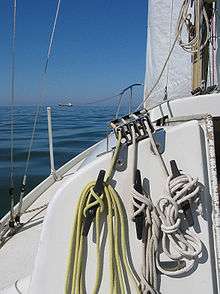Standing rigging

On a sailing boat, standing rigging generally refers to lines, wires, or rods which are more or less fixed in position while the boat is under sail. This term is used in contrast to running rigging, which represents elements of rigging which move and change fairly often while under sail. Standing rigging is placed under tension to keep the various spars (mast, bowsprit) securely in position and adequately braced to handle loads induced by sails.[1]
Description
On modern yachts, standing rigging is often stainless steel wire, stainless steel rod or synthetic fiber. Semi-rigid stainless steel wire is by far the most common as it combines extreme strength, relative ease of assembling and rigging with reliability. Unlike rigid stainless steel rod, it is comparatively easy to recognize wear and stress as individual strains (normally 19) break often near a swage fitting, and can be inspected while standing. Solid rod stainless steel is more aerodynamic so is often used in extreme racing yachts but it is difficult to see stress as this requires x-raying. Great care must be used when swaging fittings onto stainless steel rod as this can start minute cracking. Rod-type stays fail suddenly, often where the rod bends around a spreader. Bending can induce unseen stress fractures.
Early sailing vessels used rope of hemp or other fibers, which gave way to wire ropes of various types. Galvanized steel was common for most of the 20th century, though eclipsed since the 1960s by stainless steels, but is still used by sailors on a budget or in third-world countries. Highly engineered racing yachts have recently begun to use composite fiber line and rod for standing rigging, with the goal of reducing weight aloft.
Typically, a modern sailboat rigged as a sloop will carry the following pieces of standing rigging: a forestay, a backstay, and upper and lower shrouds (side stays). Less common rigging configurations are diamond stays and jumpers. Both of these are used to keep a thin mast in column especially under the load of a large down wind sail or in strong wind. Rigging parts include swageless terminals, swage terminals, shackle toggle terminals and fail safe wire rigging insulators
Sources
- ↑ Keegan, John (1989). The Price of Admiralty. New York: Viking. p. 280. ISBN 0-670-81416-4.